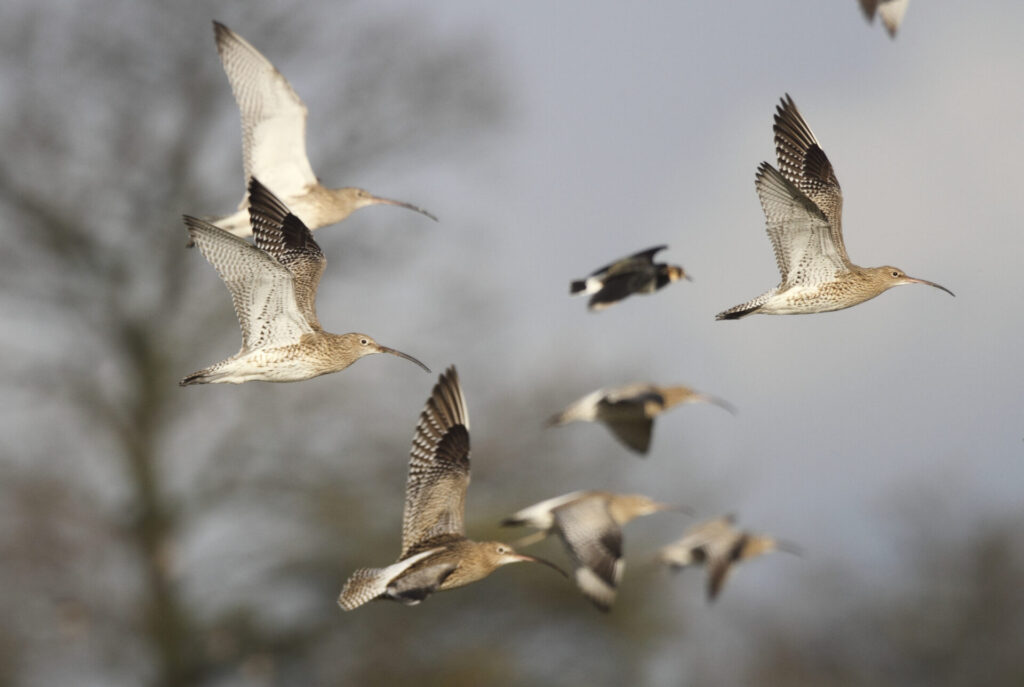Urgent call for help to protect Nidderdale’s Curlew
Published on 17th April 2025

Nidderdale National Landscape (NNL) is urgently appealing for help to protect the iconic and much-loved Eurasian Curlew, which is in serious decline.
The curlew’s distinctive call signals spring like no other, but the UK population has fallen by a staggering 48pc over a 25-year period between 1995 and 2020 and it was added to the UK red list for threatened species with the highest conservation priority in 2015.
They’re a familiar sight across Nidderdale, however, while adult curlews return to the area each February, their presence is likely masking a sharp decline in breeding success here too. NNL is offering huge support to enable landowners, farmers and the public to what they can to help alter the trend.
Matt Trevelyan, farming in protected landscapes officer at NNL, said: “It’s tempting to assume that because we see numbers of adult curlews, populations are stable. But what really matters is the number of fledged chicks at the end of summer—those are the birds that will sustain the population in the future.
“A recent Nidderdale study shows that breeding success on farms is poor; the curlews we see are largely likely to be mature adults without enough young to replace them. If this trend continues, we could face a sudden and catastrophic decline.
“Every nest, egg, and chick matters,” Matt says. “At least 10,000 more chicks need to fledge each year just to halt the decline. With the right support, we can turn the tide together.”
Nidderdale hosts an internationally important population of breeding curlew, yet awareness of their plight remains low.
“Some former strongholds have already fallen silent. To imagine a future where children never hear a curlew’s cry is deeply troubling,” he said.
As national statistics show, the decline in curlew populations is stark elsewhere: in mainland Ireland, the number of nesting pairs has plummeted from 150,000 in the 1960s to just 150 today. Breeding curlews are predicted to be extinct in Wales by 2033.
“Without concerted effort, Nidderdale’s curlews could follow the same trajectory,” warns Matt. “Parts of England, such as Dartmoor, are already seeing the possibility of local extinction.”
Research by the Northern Upland Chain Local Nature Partnership (NUC LNP) highlights Nidderdale’s importance: 49% of England and Wales’ breeding curlew population is found within just 4.9% of the land area, including Nidderdale National Landscape. Yet despite this, breeding failures are widespread, largely due to farming intensification, landscape changes, and increased predation.
“We all have the power to change outcomes for curlew,” Matt says. “The National Landscape team has a range of positive actions that everyone can take part in. From simple everyday actions like keeping dogs on leads to more involved efforts such as habitat management, there are many ways to support curlew conservation.
“Farmers and contractors often have a special relationship with farmland birds such as curlew and lapwing,” Matt explains. “Managing land for curlew doesn’t mean stop farming – we want to work with all land managers to find practical solutions that can work for both.
“Many farmers already take steps to protect nests—cutting around them, delaying mowing, or checking fields for chicks. However, not all land managers are aware of the curlew’s red-listed status or what they can do to help.”
In terms of a legacy, Matt says curlew conservation requires tailored habitat management, which means farmers need targeted advice and financial assistance, but confidence in government support is low, and many farmers are unable to access environmental payments.
He said: “The government must provide long-term investment and certainty, ensuring farmers are rewarded for sustainable land stewardship. Beyond reinstating an improved SFI scheme, we also need dedicated funding for curlew conservation officers and projects.”
For more information on how to get involved see guidance below and contact Matt Trevelyan on:
Email: [email protected]
Mobile: 07745 544 872
ENDS
Notes to Editors:
How people can help
From simple everyday actions like keeping dogs on leads to more involved efforts such as habitat management, there are many ways to support curlew conservation.
For landowners and farmers:
Curlews thrive in traditional farmland settings, and simple changes can make a huge difference:
- The National Landscape team can provide advice on conservation and regenerative practices that benefit both curlew and farm resilience.
- We can connect landowners with curlew conservation volunteers.
- Grant funding is available for equipment like nest fences and cameras.
- We can help farmers access agri-environment schemes as they become available.
For the general public:
- Keep dogs on leads. During breeding season, ground-nesting birds are highly vulnerable to disturbance.
- Donate to our dedicated fund to help save the curlew https://www.ydmt.org/donate-nidderdale
- Spread the word. If you live near a nesting site or own land with footpaths, put up polite signs to alert walkers. Nidderdale National Landscape and Curlew Action can provide ready-made signs, or you can design your own.
- Write to newspapers and MPs. Public awareness and political action are crucial for securing better conservation policies.
- Volunteer for fieldwork. Whether you’re an expert or a beginner, there are plenty of ways to get involved in monitoring and conservation efforts.
- Help record curlew sightings. Data is essential to direct conservation efforts effectively. Our Curlew Survey App makes it easy to log sightings and contribute to vital research.
How to access the app:
- Download the Coreo app from the iOS (Apple) or Android (Google Play) store.
- Join the Nidderdale Curlews project using the code GI-659584.
- From the home screen, click the + button to add a sighting.